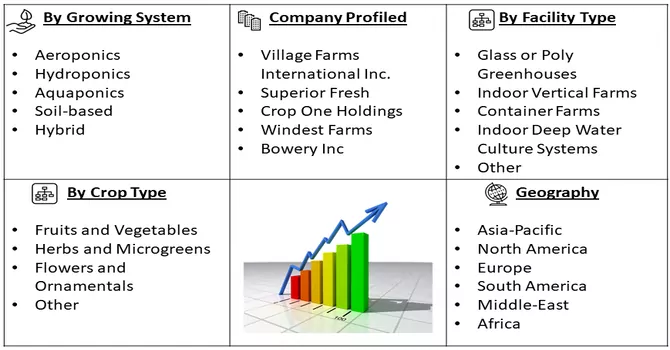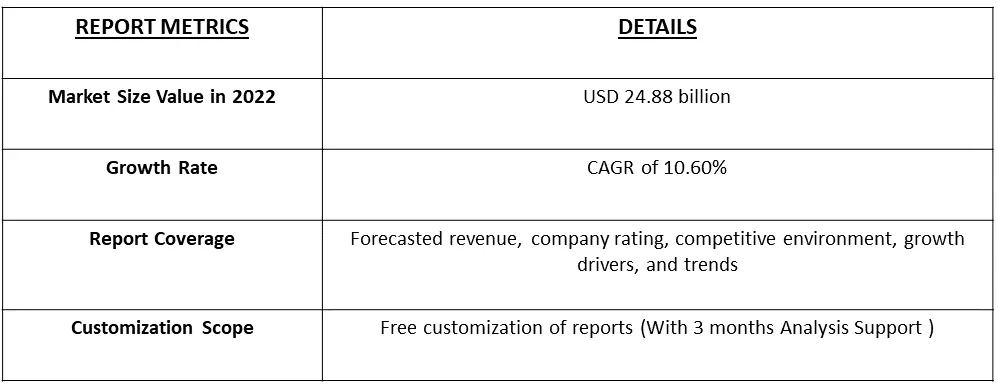The Indoor Farming Market size is currently valued at USD 24.88 billion in 2022, registering a CAGR of 10.60% during the forecast period (2023-2030).

Get Complete Analysis Of The Report - Download Free Sample PDF
Indoor farming, also referred to as vertical farming or controlled environment agriculture, is a method of cultivating crops and producing food within enclosed structures. These structures can take the form of greenhouses, warehouses, or purpose-built facilities. Within these controlled environments, various parameters like temperature, humidity, light exposure, and nutrient levels are precisely managed to optimize the growth conditions for plants.
Indoor farming utilizes advanced hydroponic and aeroponic systems that can significantly reduce water consumption compared to traditional agriculture. Additionally, it allows for precise control over nutrient delivery, reducing resource wastage. Indoor farming can have a smaller environmental footprint, as it reduces the need for land, pesticides, and long transportation distances for fresh produce. This aligns with sustainability and environmental conservation goals.
Market Segmentation: Global Indoor Farming Techonology Market is Segmented by Growing System (Aeroponics, Hydroponics, Aquaponics, Soil-based, and Hybrid), Facility Type (Glass or Poly Greenhouses, Indoor Vertical Farms, Container Farms, Indoor Deep Water Culture Systems, and Other Facility Types), Crop Type (Fruits and Vegetables, Herbs and Microgreens, Flowers and Ornamentals, and Other Crop Types), and Geography (North America, Europe, Asia-Pacific, South America, and Africa). The report offers market size and forecasts for the abovementioned segments in terms of value in USD million.

For Detailed Market Segmentation - Download Free Sample PDF
Market trends within the indoor farming sector mirror the shifting dynamics of agriculture and food production. These trends are propelled by technological progress, a focus on sustainability, and evolving consumer choices. One noteworthy trend is the increasing prominence of vertical farming. This innovative approach entails the stacking of multiple crop layers in a vertical configuration. It is gaining traction due to its exceptional space efficiency and the potential for higher crop yields per square foot. Another significant trend is the ongoing evolution of LED lighting technology. LEDs are becoming more energy-efficient and cost-effective, particularly for indoor farming. Furthermore, there is a growing emphasis on customizing lighting spectrums to maximize plant growth and optimize photosynthesis.
Market Drivers:
Water and Resource Efficiency
Water and resource efficiency are critical aspects of the indoor farming market, contributing to the sustainability and economic viability of this agricultural practice. Indoor farming, also known as controlled environment agriculture (CEA), encompasses various techniques and technologies that optimize the use of resources, particularly water and energy. Indoor farming systems, such as hydroponics and aeroponics, are designed to significantly reduce water consumption compared to traditional soil-based agriculture. These systems recirculate water, delivering it directly to plant roots, minimizing waste through evaporation or runoff. Indoor farming enables year-round crop production, eliminating the seasonal fluctuations and resource inefficiencies associated with traditional agriculture. Thus, owing to such advantages the market is expected to witness significant growth over the forecast period.
Reduced Environmental Impact
Market Restraints :
Indoor Agriculture Market High Initial Investment
The setup of indoor farming facilities, including infrastructure, lighting, climate control systems, and automation, requires a substantial initial investment. This can be a barrier for newcomers to the industry. Moreover, Indoor farming consumes a significant amount of energy to maintain the controlled environment, including lighting, heating, and cooling systems. High energy costs can impact the overall profitability of indoor farms, especially in regions with expensive electricity. Thus, these factors may slow down the growth of the studied market.
The pandemic underscored the importance of food security and access to fresh produce. As a result, there has been a heightened demand for locally grown and sustainable food sources, which indoor agriculture can provide. The initial wave of COVID-19 led to disruptions in supply chains, affecting the availability of agricultural inputs and equipment. This presented challenges for indoor farming operations, which rely on specialized technologies and resources. The pandemic increased awareness about health and well-being, prompting more people to prioritize fresh and healthy food choices. Indoor-grown produce, often free from pesticides and contaminants, aligns with this growing consumer demand. Thus, COVID-19 has both presented challenges and created opportunities for the indoor agriculture industry. While there were initial disruptions and uncertainties, indoor farming has gained recognition for its role in ensuring a stable food supply and promoting local, sustainable, and healthy food options.
Segmental Analysis
Hydroponics Segment is Expected to Witness Significant growth over the Forecast Period
Hydroponics and indoor agriculture are closely intertwined, as hydroponic systems represent one of the primary methods used for cultivating crops within controlled indoor environments. Hydroponics is a soilless farming technique that relies on the delivery of water, nutrients, and oxygen directly to plant roots. Hydroponics is highly resource-efficient, as it conserves water by recirculating it within closed-loop systems. The controlled environment of indoor agriculture complements hydroponics by preventing water loss due to evaporation or runoff. Thus, owing to such advantages the segment is expected to witness significant growth over the forecast period.
Indoor Vertical Farms Segment is Expected to Witness Significant growth over the Forecast Period
Indoor vertical farms use shelving or stacking systems to grow crops in multiple layers, allowing for increased plant density and production within a compact footprint. Vertical farms provide a controlled environment where factors such as temperature, humidity, lighting, and nutrient delivery can be finely tuned to optimize crop growth and yield. Indoor vertical farms often employ precision agriculture technologies, including IoT sensors, data analytics, and automation, to monitor and manage environmental conditions and crop health in real-time. Thus owing to such advantages, the segment is expected to witness significant growth over the forecast period.
Herbs and Microgreens Segment is Expected to Witness Significant growth over the Forecast Period
Herbs and microgreens are two distinct but closely related categories of crops that have gained significant popularity in the culinary world and indoor farming. Herbs have long been integral to culinary traditions worldwide. They are used to enhance the flavour of various dishes, from soups and sauces to salads and main courses. Some indoor farms engage with local communities, offering educational programs, workshops, and farm-to-table experiences to promote awareness of sustainable agriculture. Thus, owing to such advantages, the segment is expected to witness significant growth over the forecast period.
North America Segment is Expected to Witness Significant growth over the Forecast Period
North America has been a key region in the global indoor agriculture market, witnessing significant growth and innovation in this sector. The indoor agriculture market in North America is shaped by a combination of factors, including technological advancements, sustainability initiatives, and the changing landscape of agriculture.
North America has been at the forefront of technological innovations in indoor agriculture. The region has seen the development of advanced automation, environmental control systems, and data analytics, which enhance the efficiency and productivity of indoor farms. Thus, owing to such advantages, the segment is expected to witness significant growth over the forecast period.

Get Complete Analysis Of The Report - Download Free Sample PDF
The market for indoor farming is highly fragmented, with the top players accounting for a minor share and the other small companies capturing a major share in the market. The market is highly fragmented, with major revenue-generating companies, which are:
Recent Development
1. April 2021: Aerofarms partnered with Hortifrut SA, a certified B corporation in Chile. The partnership is expected to focus on researching and developing blueberry and cranberry production in fully-controlled vertical farms and indoor environments.
2. May 2021: BrightFarms opened its latest indoor farm in Hendersonville, North Carolina. The 6-acre greenhouse is expected to produce 2 million pounds of lettuce per year. Similarly, in 2019, Bright Farms expanded its construction unit with three new sustainable greenhouse farms in Massachusetts, New York, and North Carolina.
Q1. What is the current Indoor Agriculture Market size?
The Indoor Agriculture Market size is currently valued at USD 24.88 billion.
Q2. At what CAGR is the Indoor Agriculture Market projected to grow within the forecast period?
Indoor Agriculture Market is registering a CAGR of 10.60% during the forecast period.
Q3. Which region has the largest share of the Indoor Agriculture Market? What are the largest region's market size and growth rate?
North America has the largest share of the market. For detailed insights on the largest region's market size and growth rate request a sample here.
Q4. Which are the major companies in the Indoor Agriculture Market?
Village Farms International Inc., Superior Fresh and Crop One Holdings are some of the major companies in the Indoor Agriculture Market.
Data Library Research are conducted by industry experts who offer insight on industry structure, market segmentations technology assessment and competitive landscape (CL), and penetration, as well as on emerging trends. Their analysis is based on primary interviews (~ 80%) and secondary research (~ 20%) as well as years of professional expertise in their respective industries. Adding to this, by analysing historical trends and current market positions, our analysts predict where the market will be headed for the next five years. Furthermore, the varying trends of segment & categories geographically presented are also studied and the estimated based on the primary & secondary research.
In this particular report from the supply side Data Library Research has conducted primary surveys (interviews) with the key level executives (VP, CEO’s, Marketing Director, Business Development Manager and SOFT) of the companies that active & prominent as well as the midsized organization
FIGURE 1: DLR RESEARH PROCESS

Extensive primary research was conducted to gain a deeper insight of the market and industry performance. The analysis is based on both primary and secondary research as well as years of professional expertise in the respective industries.
In addition to analysing current and historical trends, our analysts predict where the market is headed over the next five years.
It varies by segment for these categories geographically presented in the list of market tables. Speaking about this particular report we have conducted primary surveys (interviews) with the key level executives (VP, CEO’s, Marketing Director, Business Development Manager and many more) of the major players active in the market.
Secondary ResearchSecondary research was mainly used to collect and identify information useful for the extensive, technical, market-oriented, and Friend’s study of the Global Extra Neutral Alcohol. It was also used to obtain key information about major players, market classification and segmentation according to the industry trends, geographical markets, and developments related to the market and technology perspectives. For this study, analysts have gathered information from various credible sources, such as annual reports, sec filings, journals, white papers, SOFT presentations, and company web sites.
Market Size EstimationBoth, top-down and bottom-up approaches were used to estimate and validate the size of the Global market and to estimate the size of various other dependent submarkets in the overall Extra Neutral Alcohol. The key players in the market were identified through secondary research and their market contributions in the respective geographies were determined through primary and secondary research.
Forecast Model
